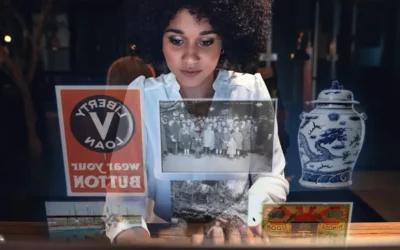Do You Know the Millennial Museum Donor?

Rachael Cristine Woody
Are you thinking about millennials when you review your donor cultivation and development activities? As of 2020, millennials are now half of the workforce and their disposable income will increase once baby boomers eventually transfer their wealth.
With this new shift in buying power it’s important to realize that this demographic has a different set of core values that determine when and how they spend their money. The millennial donor is different and it’s important to note that millennials are not waiting for retirement—they’re engaging now. This provides a short-term and immediate benefit for the museum with the likelihood of the more traditional long-term benefits exhibited by previous donor types.
Millennial Behavior Shows an Increase in Social Engagement
According to The 2017 Millennial Impact Report (the most recent report available at the time this post was written), millennials have shown an increase in their social engagement behavior in the following categories:
- 42% post to social media in support or protest of a topic
- 40% sign petitions
- 37% purchase products and services based on perceived ethics of the company
- 35% give to charities
- 31% volunteer
- 27% contact political representatives
- 25% join and serve on nonprofit boards
Additionally, the report finds that millennials tend to engage more at the local level. Notably, their engagement at the local level doesn’t appear to impede their engagement with national issues.
How Does This Relate to Museums?
When reviewing the social engagement activities listed above we can see how they may translate or be related to museum support. By paying attention to the engagement methods millennials prefer, museums can tap into millennial engagement behavior. Let’s look at each engagement behavior and review how it may translate to millennial support for the museum.
- Social Media: Effectively engage millennials on social media by tying museum items and events to a social issue. There needs to be a meaning or purpose to the post in order to be attractive to this audience. If there is a call to action then make it clear what the request is.
- Petitions & Writing Representatives: When museum funding is threatened or a call to action is needed, the museum can ask millennials to sign a petition in support of the museum. Additionally, millennials will write their representatives and if the museum needs representative support they should draft sample letters for millennials to take and send to their representatives on the museum’s behalf. To make this easy, the museum needs to write a concise and compelling draft letter with clear instructions for where and how to send it.
- Ethics-Driven Purchasing and Donating: By being transparent on the museum’s ethics, a museum can attract millennial dollars. Millennials want to give to charities that align with their social values and where they perceive active work is under way. When the museum makes a donation call, make sure the call is specific and demonstrates the actions that are made possible with every dollar.
- Volunteer & Board Service: Millennials want to give their time to help further a cause. If museums can offer purpose-based volunteer opportunities with visible products or accomplishments, they will have an easier time attracting the millennial volunteer. With a healthy base of millennial volunteers, the museum can select new Board members to help bring a new energy and perspective to the museum from a demographic that will soon hold the highest buying (and giving) power.
And remember, millennials prefer to first engage locally. By creating an inviting space for the local millennial population, the museum can cultivate a powerful base that is active at the local level.
Find the “Why”
As with any donor case, it’s important to investigate and understand the “why” to their giving.
An IMPACTS research study as reported by Colleen Dilenschneider shows the top five reasons for why millennials donate:
- They want to “join” or “be a part of something”
- Support the mission
- Internal satisfaction/personal benefit
- Set example for others
- Asked to give by staff/board member
Compared to non-millennials:
- Asked to give by a friend or family member
- Asked to give by a staff/board member
- Set example for others
- Internal satisfaction/personal benefit
- Tax benefit
The top two items listed for millennials happen to be the two items where they differ from the non-millennial group. Millennials are paying attention to the mission because they prioritize investing in things that align with their values. A museum’s mission is a statement of the museum’s values. A set of shared mutual values are what creates a community. Since the millennial number one reason to give is to “join” or “be a part of something” it makes sense that these top two items are together.
Conclusion
From 2020 onward millennials will become an increasingly and influential demographic. Smart museums will shift their attention, recruiting, and cultivation efforts to this population in order to capture the loyalty and engagement energy that is a hallmark of this group. The sooner museums know their millennial donors the better off they’ll be in both the short and long-term.

Rachael Cristine Woody
Consultant, author, and blogger Rachael Cristine Woody advises on museum strategies, collections management, grant writing and the future of museums for a wide variety of clients. Download your free copy of Rachael’s book from Lucidea Press, A Survivor’s Guide to Museum Grant Writing
Similar Posts
Storytelling to Inspire Reflection Using Museum Collections Online
Storytelling with online collections is impactful, whether we choose online-only or as part of a hybrid approach to museum exhibitions.
Museum Collections Online: Learning Through Storytelling
Digitizing museum collections introduces new and engaging opportunities for storytelling. By leveraging digital surrogates—essentially online representations of physical objects—museums can enhance how they present narratives and information to audiences.
The Role of Museum Collections Online in Storytelling & Audience Engagement
Storytelling with museum collections online allows for a great degree of flexibility, offers additional detail, and lends a dynamism that is difficult to produce within a physical exhibition.
Examples of How Archives Can Be Used to Elevate Museum Collections
Last week we reviewed how archives can enhance museum collections online. This week will continue our work with an examination of specific examples, including what items different types of archives may contain and where to capture this data.




Leave a Comment
Comments are reviewed and must adhere to our comments policy.
0 Comments